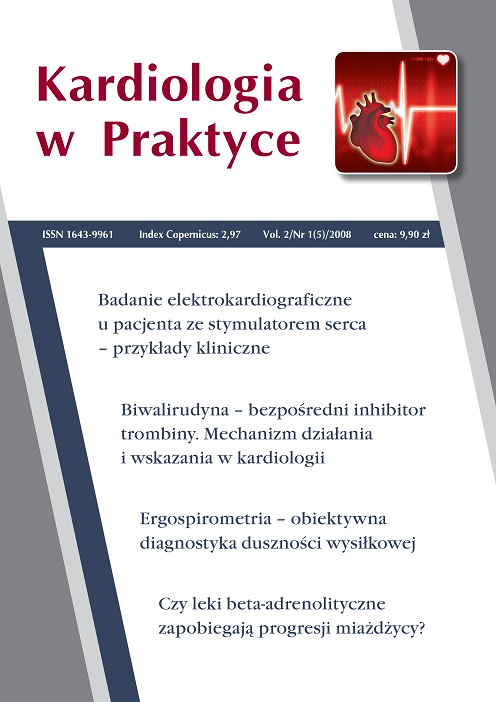Atrial septal aneurysm – echocardiographic assessment and clinical relevance Review article
Main Article Content
Abstract
Atrial septal aneurysm (ASA) is a common congenital anomaly with prevalence of 1–2% in general population. In majority of patients with ASA patent foramen ovale might be found. Echocardiography, both transthoracic and transesophageal is major diagnostic tool for diagnosis and assessment of ASA. Clinical relevance of ASA is uncertain. Its potential role in rhythm disturbances and cryptogenic stroke is discussed.
Downloads
Article Details

This work is licensed under a Creative Commons Attribution-NonCommercial-NoDerivatives 4.0 International License.
Copyright: © Medical Education sp. z o.o. This is an Open Access article distributed under the terms of the Attribution-NonCommercial 4.0 International (CC BY-NC 4.0). License (https://creativecommons.org/licenses/by-nc/4.0/), allowing third parties to copy and redistribute the material in any medium or format and to remix, transform, and build upon the material, provided the original work is properly cited and states its license.
Address reprint requests to: Medical Education, Marcin Kuźma (marcin.kuzma@mededu.pl)
References
2. Silver M.D., Dorsey J.S.: Aneurysms of the septum primum in adults. Arch. Pathol. Lab. Med. 1978, 102: 62.
3. Pearson A.C., Labovitz A.J., Tatineni S. et al.: Superiority of transesophageal echocardiography in detecting cardiac sources of embolism in patients with cerebral ischemia of uncertain etiology. J. Am. Coll. Cardiol. 1991, 17: 66.
4. Agmon Y., Khandheria B.K., Meissner I. et al.: Frequency of atrial septal aneurysms in patients with cerebral ischemic events. Circulation 1999, 99: 1942.
5. Mattioli A.V., Aquilina M., Oldani A. et al.: Atrial septal aneurysm as a cardioembolic source in adult patients with stroke and normal carotid arteries. Eur. Heart J. 2001, 22: 261.
6. Meissner I., Khandheria B.K., Heit J.A. et al.: Patent foramen ovale: innocent or guilty. Evidence from a prospective population based study. J. Am. Coll. Cardiol. 2006, 47: 440.
7. Cabanes L., Coste J., Derumeaux G. et al.: Interobserver and intraobserver variability in detection of patent foramen ovale and atrial septal aneurysm with transesophageal echocardiography. J. Am. Soc. Echocardiogr. 2002, 15: 441.
8. Kuhl H.P., Hoffman R., Merx M.W. et al.: Transthoracic echocardiography using second harmonic imaging. Diagnostic alternative to transesophageal echocardiography for the detection of atrial right to left shunt in patients with cerebral embolic events. J. Am. Coll. Cardiol. 1999, 34: 1823.
9. Schneider B., Hofmann T., Meinertz T.: Is there an association of atrial septal aneurysm with arrhythmias? Cardiology 1999, 91: 87.
10. Belkin R.N., Hurwitz B.J., Kisslo J.: Atrial septal aneurysm: association with cerebrovascular and peripheral embolic events. Stroke 1987, 18: 856.
11. Di Pasquale G., Andreoti A., Graxi P. et al.: Cardioembolic stroke from atrial septal aneurysm. Stroke 1988, 19: 640.
12. Grosgogeat Y., Lhermitte F., Carpentier A. et al.: Aneurysme de la cloison interauriculaire révélé par une embolie cérébrale. Arch. Mal. Coeur. 1973, 66: 169.
13. Overell J.R., Bone I., Less K.R.: Interatrial septal abnormalities and stroke: a meta-analysis of case-control studies. Neurology 2000, 55: 1172-1179.
14. Mas J.L., Arquizan C., Lamy C. et al.: Recurrent cerebrovascular events associated with patent foramen ovale, atrial septal aneurysm, or both. N. Engl. J. Med. 2001, 345: 1740.
15. Handke M., Harloff A., Olschewski M. et al.: Patent Foramen Ovale and Cryptogenic Stroke in Older Patients. N. Engl. J. Med. 2007, 357: 2262.
16. Khairy P., O’Donnell C.P., Landzberg M.J.: Transcatheter closure versus medical therapy of patent foramen ovale and presumed paradoxical thromboemboli: a systematic review. Ann. Intern. Med. 2003, 139: 753.

